Live video update.
Michel Burnand, HB9DUG now has live video running. See here for photographs, and a comprehensive, **single document** setup guide. This now includes a much less CPU intensive solution which replaces FFmpeg with a much simpler 'pesdemux' module.
Progress
Ben's (USA) FPGA main modulator code is now fully working at 4M syb/sec. For an update, see here. This page includes a link to the design source, at the bottom.
Recent experiments in ZL indicate that IRD/RX sensitivity improves (considerably) with lower bandwidth, I managed to get solid video from an SRT4260x Strong IRD + preamp from a -100dBm signal (2.3uV RMS) at 4M sym/sec and 1/2 puncture codes. Most interested to hear about performance of other modulator/RX combinations.
Malcolm Johnson (G0UHY) has a unit running in the UK.
Some animated test cards (colour bars, clock, callsign) have been created, email me for scripts, process, and details.
Background
This web site is very much a work-in-progress, so please excuse its brevity. Updates are likely to occur frequently, and without announcments in the popular press, so please bookmark this page.
With the impending closure of the 615MHz analogue TV allocation for use by the Amateur Radio fraternity in New Zealand, this project was undertaken as a starting point to understand some of the issues associated moving into the Digital Amateur TV (DATV) arena.
Several hurdles are associated with the generation of DATV, not the least being:
For long and varied reasons, DVB-S is the chosen modulation, non-the-least because of readily available set-top boxes (IRDs) which can directly support a 1.3GHz RF interface without frequency translation. Also, this modulation is the least complex.
This project follows in the steps of several forerunners, the real starting point being the excellent work of Jean-François Fourcadier, F4DAY with this project “The POOR MAN's DIGITAL ATV TRANSMITTER”.
After further investigation, work was found by Rob Swinbank, M0DTS in the UK who had made some improvements and demonstarted a Linux based video encoder and multiplexer configuration. Rob also provided considerable encouragement with my quest to move the project further forward. He pointed me at the DigiLite web site...
The Digilite project has taken Rob’s work and moved into a more accessible and reproducible form. The main effort for this project appears to be Brian Jordan G4EWJ, Dave G8AJN and Malcolm Johnson, G0UHY.
At this point it is worth mentioning that G4EWJ has been a total hero. He has provided me a huge amount of support without a single complaint.
Also worth a mention is Grant, ZL1WTT with his work on multiple stream generation using a cluster of PCs using Linux (with similarities to Rob's work). There are lots of aspects of this project that I intend to follow though on, and learn about.
DigiLite-ZL
The Digilite project from the UK is quite close to my needs, but the ability to build a complete open source digital TV transmit chain without the need of a PC (so it can be used as a part of a repeater in a remote location) still required some hooks.
Before we go any further I need to say out loud that this project is not intended to compete with DigiLite in any way. The goals of these two projects are quite different. DigiLite is a low cost modulator, supported by the sale of kits through the BATC and is intended as a complete low cost DVB-S transmit solution.
While DigiLite-ZL is DigiLite compatible, it is intended as an open source development platform to allow alternate methods of signal generation and modulation using an FPGA, while still supporting the high speed PC USB interface for development.
So, by using the bulk of the DigiLite design, but adding an interface to an FPGA, it should be possible to do all interface and modulation in hardware. A source of realtime MPEG video can be found from a home TV recorder (DVR) with the appropriate de-multiplexing of Program Stream to audio and video elementary streams. These streams can then me re-muxed with appropriate SI tables into a Transport Stream.
Features
FPGA
The DE0-nano is a lovely small, low cost FPGA development board manufactured by terasIC and is supported by the Altera (free) Quartus II development software. Interface to DigiLite-ZL is by way of a 40 conductor ribbon cable with power being supplied from its own USB connection of from the DigiLite-ZL board. Ben Gelb has created a full DVB-S modulator in verilog for the FPGA, details are available here.
Team Effort
I have been lucky enough to find a very competent design team including an FPGA designer Ben Gelb, N1VF who has offered to do the bulk of the work on the FPGA development.
On the RF side, I have had support from Alan Page, ZL3UYJ who was invaluable helping with design reviews along with beating sense into me about PCB layout topology and component selection issues.
Also, Brian Jordan has spent numerous hours answering my daft questions, peering at schematics, and head scratching on my behalf.
For all of his work documenting live video for the project, I would like to thank Michel Burnand, HB9DUG. A seperate page has been added detailing how to configure a PC to support live video for DigiLite-ZL
Many thanks also go to Tim P and Peter R who helped advise and upgrade our existing SKY system to support some of these experiments.
Last, but by no means least, Kerry and Gerry from Molten Media Community Trust who have helped source some of the equipment that has been used with this project.
Progress
Ten PCBs have been manufactured and one loaded. Video bias turned out to be more of an issue than I first thought, so the design has required 4 extra resistors to be added. Also, I managed to get the silkscreen of the LED backwards.
Characterization of the RF section is complete, the output amplifier appears to have about 8dB headroom, so should be quite linear. A temperature sweep of the unit from +5 to +50oC did not affect performace significantly. VCO temperature coefficient appears to be in the order of -70kHz per oC.
Work is required to get the PicKit2 programmer interface working. Possibly the addition of two diodes to hold the USB module in reset (M1-208 to GND) and enabling power (TR1-3 to GND) via a switch to GND.
The following photos are taken of the DigiLite-ZL hardware running stock DigiLite software and firmware.
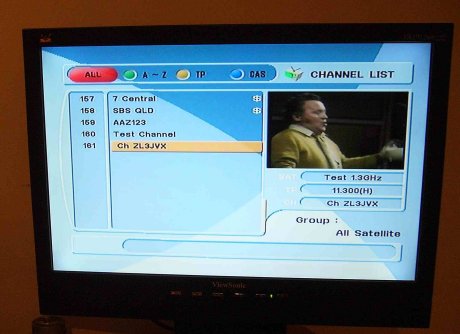
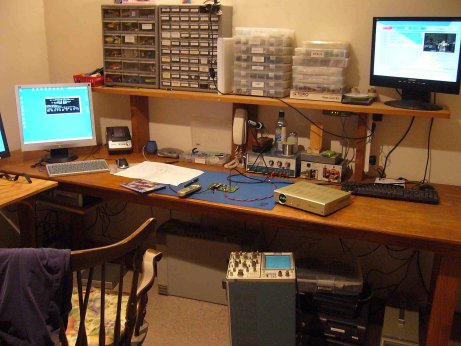
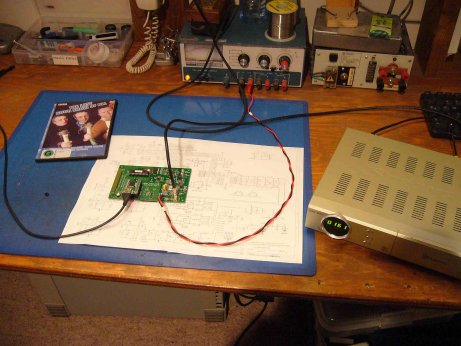
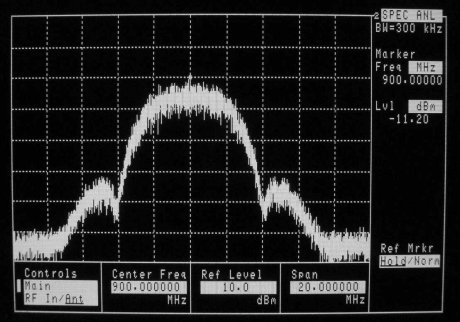
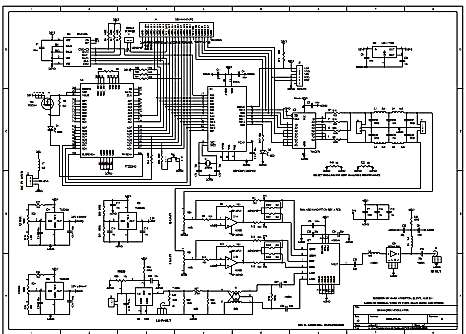
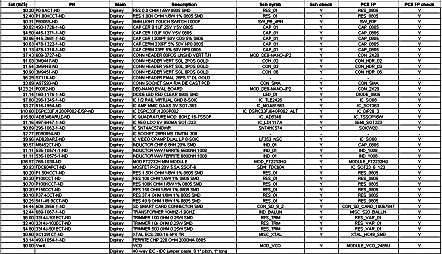
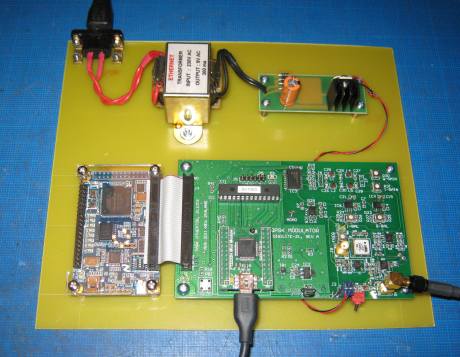
Conversations
As I hoped, this project initiated some interesting conversations. Amongst others, I received an email from Dan, EI9FHBR
Presentation
Here is a powerpoint that was prepared for the Christchurch Robtics Group. Not everyone took my first talk on the project too seriously (thank goodness :), mind you, it was talk-like-a-pirate-day.
Forwards
Robin mentioned that Hauppauge are selling a USB based MPEG2 encoder solution. The units appears to be able to run at USB 1.1 rates, so should be reasonably easy to interface with.
Comments and corrections always welcome.
Regards,
15 Aug 2012, New Zealand
